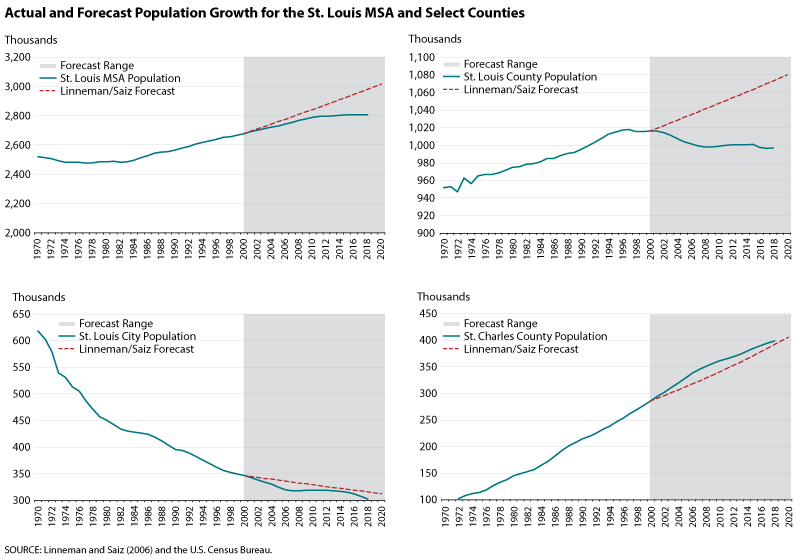Why Is the St. Louis Metro Area Population Growing So Slowly?
From 2000 to 2018, the population of the St. Louis metropolitan statistical area (MSA) increased from 2.68 million to 2.80 million,1 a cumulative growth rate of 4.7 percent. That's less than the national growth rate of 19.9 percent over the same period and less than the rates of nearby, similar-sized MSAs, such as Kansas City (17.9 percent) and Nashville (39.2 percent).The St. Louis MSA hasn't always had stagnant population growth, however: In the last decade of the 20th century, its population grew much faster. So why has its growth tapered off since 2000? 2
The St. Louis MSA's growth slowdown may be due to economic reasons: Regional characteristics that impact business productivity (i.e., benefits to firms) or amenities (i.e., benefits to households) may have declined relative to other MSAs, leading to outward migration.3 Or perhaps different demographics have produced differences in net birth rates. Comparing actual population growth with forecasted growth may help identify the cause of the decline.4

The table summarizes population data for the St. Louis MSA and the five most populous counties. Five of the fifteen counties in the MSA experienced population declines between 2000 and 2018, with the largest absolute and percentage declines in St. Louis City (–44,300, –13 percent). The other 10 counties gained population, with the strongest growth in St. Charles County (+113,000, +40 percent). These significant shifts of population from St. Louis City toward outlying suburbs continue previous trends.5
Economists Peter Linneman and Albert Saiz (2006) developed a model to forecast county population growth6 using data such as the distribution of ages in a population, the presence of immigrants, climate, and population density. Counties with low density (i.e., non-MSA counties) and density above a certain threshold (i.e., high-density central city counties) grow more slowly.7 Their model can explain 75 percent of the variation in county population growth rates between 1980 and 2000.

The model's forecasts for 2000 to 2020 provide a counterfactual against which to compare the actual data: The model projected slow and steady growth of 11 percent for the St. Louis MSA, with a population of 2.98 million in 2018 and growth to 3 million by 2020 (see the top left panel of the Figure).8 In 2018, however, the St. Louis MSA was 174,900 persons below this forecast. This shortfall is likely due to relatively weaker economic performance than forecasted, leading to outward migration from the region. The forecasted values are consistent with the observed population changes in St. Louis City and St. Charles County. The actual population decline in St. Louis County makes up almost half of the St. Louis MSA's projected shortfall, with the actual St. Louis County population 76,500 persons less than the forecast. Weaker-than-forecasted population growth in Madison County (30,500 persons below forecast) and Monroe County (22,000 persons below forecast, not depicted) in Illinois are the second- and third-largest contributors to the shortfall.
In summary, over the past 18 years, the St. Louis MSA has grown at a rate less than half the rate forecasted by this model. This shortfall is not driven by unexpectedly slower net birth rates, but faster-than-expected migration out of the region. One might interpret this shortfall as indicating (i) the region has experienced declines in productivity or quality of life relative to other MSAs and, as a result, (ii) households believed they could achieve a higher quality of life by moving to a new location.
Notes
1 The St. Louis MSA is a 15-county region that spans Missouri and Illinois. At the time of publication, the most recent data available are for 2018.
2 The national population growth rate was 24 percent during the previous 17-year period, 1983 to 2000.
3 Due to a high degree of within-in country labor mobility, population growth is a better measure of a region's economic performance, while per capita income growth tends to be the preferred measure for a country's economic performance. See Glaeser, Scheinkman, and Shleifer (1995).
4 The main critique of this approach is model specification. If the researcher does not believe the model forecasts are reasonable (or on average accurate), there is little value to comparing the actual outcomes to the model forecast.
5 For a summary of economics literature on urban sprawl, see Nechyba and Walsh (2004).
6 See Linneman and Saiz (2006).
7 See Rappaport (2018).
8 By comparison, the model predicted 25.5 percent growth for the Kansas City MSA and 33.7 percent growth for the Nashville MSA.
References
Glaeser, Edward; Scheinkman, Jose and Shleifer, Andrei. "Economic Growth in a Cross-Section of Cities." Journal of Monetary Economics, 36, 1995.
Nechyba, Thomas and Walsh, Randall. "Urban Sprawl." Journal of Economic Perspectives, Fall 2004, 18(4).
Linneman, Peter and Saiz, Albert. "Forecasting 2020 U.S. County and MSA Populations." Working Paper #549, University of Pennsylvania Wharton, April 2006.
Rappaport, Jordan. "The Faster Growth of Larger, Less Crowded Locations." Federal Reserve Bank of Kansas City, Economic Review, Fourth Quarter 2018; https://www.kansascityfed.org/publications/research/er/articles/2018/4q18rappaport-faster-growth-larger-less-crowded-locations.
© 2019, Federal Reserve Bank of St. Louis. The views expressed are those of the author(s) and do not necessarily reflect official positions of the Federal Reserve Bank of St. Louis or the Federal Reserve System.


 follow @stlouisfed
follow @stlouisfed